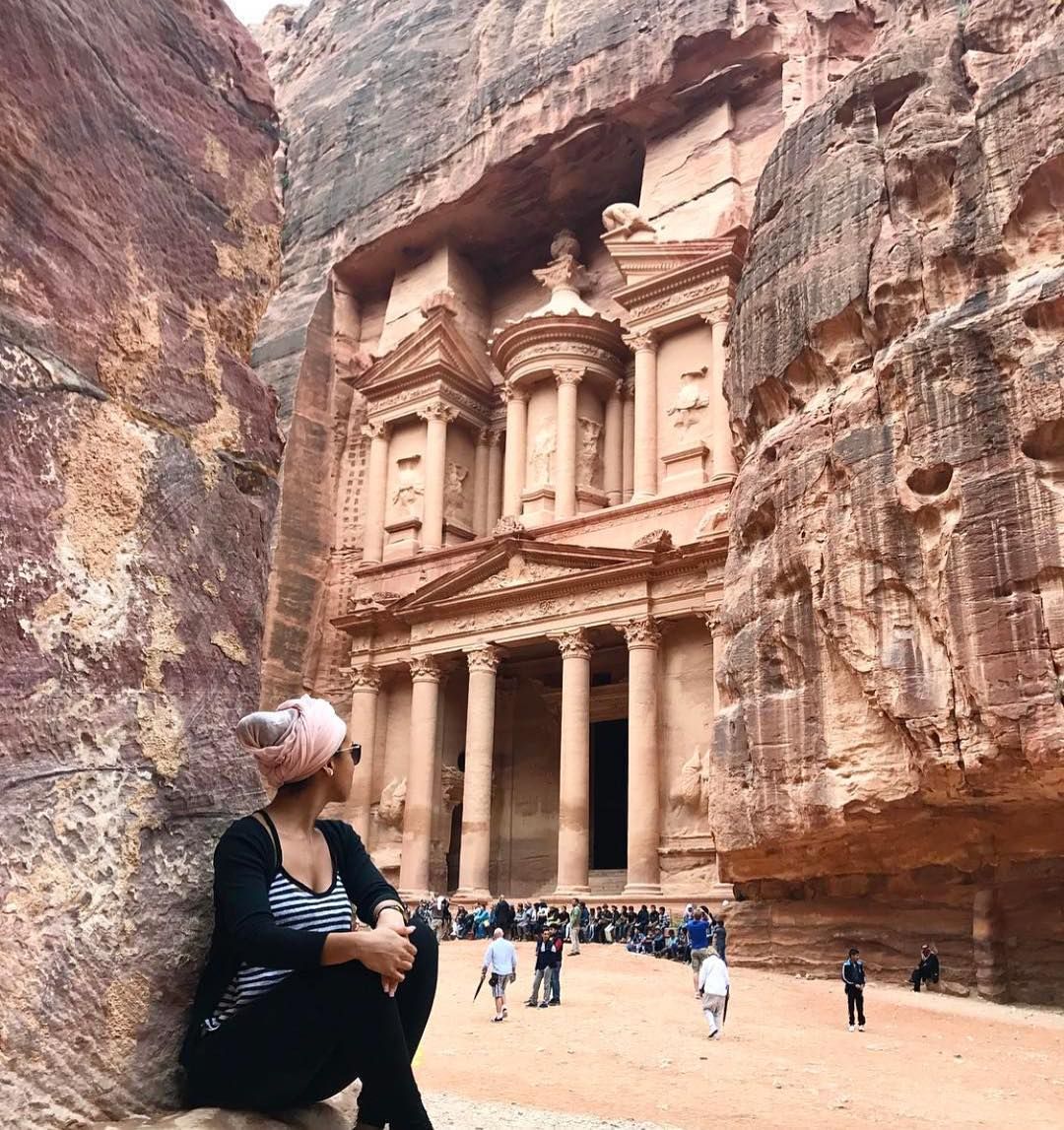
Top 10 Historical Sites for Tourists in the Jordan.
1. Petra:
2. Jerash:
3. Wadi Rum:
4. Ajloun Castle:
5. Umm Qais:
6. Madaba:
7. Kerak Castle:
8. Mount Nebo:
9. Qasr Amra:
10. Shobak Castle:
1. Petra Jordan:
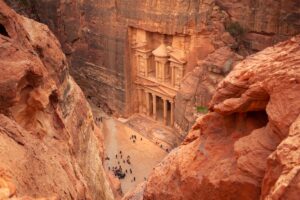
Petra, located in Jordan, is a mesmerizing ancient city that attracts tourists from all over the world.
It is one of the UNESCO World Heritage Sites in Jordan and is known for its magnificent stone-cut architecture and historical significance for tourists.
As an AI assistant, I can provide you with an overview of what to expect when visiting Petra.
Upon entering Petra through the narrow Siq, a breathtaking canyon with towering cliffs on either side, visitors are greeted by the iconic Treasury, also known as Al-Khazneh.
This intricately carved structure is one of the most photographed landmarks in Petra and is a must-see for tourists.
Exploring further into the city, visitors can marvel at the Royal Tombs, the Roman Theater, and the Monastery, all of which showcase the architectural prowess of the ancient Nabateans who once inhabited Petra.
The site is also home to numerous hiking trails, offering visitors the opportunity to explore the surrounding desert landscape and enjoy panoramic views of the city from above.
For those interested in learning more about the history of Petra, guided tours are available to provide insights into the significance of each structure and the daily life of the Nabateans.
Additionally, visitors can visit the Petra Archaeological Museum to see artifacts and exhibits related to the site’s history.
Overall, Petra is a must-visit destination for history buffs, architecture enthusiasts, and nature lovers alike.
With its stunning beauty and rich history, Petra offers a unique and unforgettable experience for tourists looking to explore one of the world’s most iconic archaeological sites.
2. Jerash Jordan:
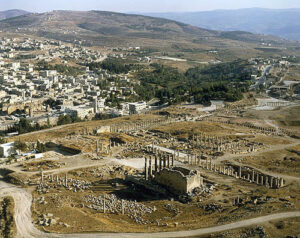
Jerash, located in Jordan, is a must-visit destination for tourists seeking a glimpse into the rich history and culture of the region.
This ancient city, often referred to as the “Pompeii of the East,” is renowned for its remarkably well-preserved Roman ruins dating back to the 1st century AD.
One of the main attractions in Jerash is the impressive Oval Plaza, a vast public space surrounded by colonnades and adorned with intricate carvings and statues.
Visitors can imagine the bustling activity that once took place in this grand square, making it a perfect spot for taking in the city’s ancient atmosphere.
The imposing Hadrian’s Arch, built to honor the visit of Emperor Hadrian in 129 AD, serves as a striking entrance to the city and offers a great photo opportunity for tourists.
The Arch leads to the Cardo Maximus, the main street of ancient Jerash, lined with shops, temples, and other structures that provide insight into daily life during Roman times.
For history enthusiasts, the South Theater is a must-see attraction in Jerash.
This well-preserved Roman theater, with a seating capacity of around 3,000 spectators, still hosts cultural events and performances, allowing visitors to experience the city’s past in a vibrant present-day setting.
In addition to its historical sites, Jerash in Jordan also offers a vibrant local market where tourists can sample traditional Jordanian cuisine, shop for souvenirs and interact with friendly locals.
With its blend of ancient ruins, cultural experiences, and warm hospitality, Jerash is a destination that promises a memorable and enriching travel experience for tourists.
3. Wadi Rum Jordan:

Wadi Rum, also known as the Valley of the Moon, is one of the historical sites and picturesque desert locations in Jordan that attract tourists from around the world.
This stunning desert landscape is characterized by towering sandstone mountains, vast red sand dunes, and ancient rock formations that have been sculpted by wind and water over centuries.
For tourists looking to experience the beauty and tranquility of the desert, Wadi Rum offers a wide range of activities and experiences.
Visitors can embark on jeep tours to explore the vast expanse of the desert, marvel at the stunning rock formations, and learn about the rich history and culture of the region from knowledgeable guides.
For the more adventurous traveler, Wadi Rum also offers opportunities for rock climbing, hiking, and even hot air balloon rides to take in the breathtaking views from above.
Camping under the stars in traditional Bedouin-style tents is a popular option for those looking to immerse themselves in the desert experience and enjoy the peace and quiet of the desert night.
In addition to its natural beauty, Wadi Rum is also home to several archaeological sites, including ancient petroglyphs and inscriptions that offer a glimpse into the region’s rich history.
Visitors can explore these sites with the help of local guides who can provide insight into the significance of these ancient artifacts.
Overall, Wadi Rum is a must-visit destination for tourists seeking a unique and unforgettable desert experience in Jordan.
Whether you’re looking to relax and unwind in the peaceful desert surroundings or embark on an adventure-filled journey, Wadi Rum has something to offer for every type of traveler.
4. Ajloun Castle Jordan:
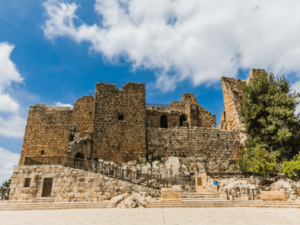
Ajloun Castle, also known as Qal’at Ar-Rabad, is a magnificent fortress located in the northern region of Jordan, offering a glimpse into the country’s rich history and architectural heritage.
Built-in the 12th century by the famous Islamic military leader Salah ad-Din, this imposing structure served as a strategic defense post against Crusader attacks and played a crucial role in protecting the region.
One of the most visited historical sites by tourists is the Al Ajloun Castle in Jordan, which is rich in both history and culture.
The castle’s well-preserved walls, towers, and chambers provide a fascinating insight into medieval military architecture, with stunning views of the surrounding countryside from its elevated position.
Visitors can wander through the labyrinthine corridors, climb the towers for panoramic vistas, and imagine life in a bygone era.
In addition to its historical significance, Ajloun Castle offers a peaceful retreat from the hustle and bustle of modern life.
The tranquil atmosphere of the castle grounds, surrounded by lush greenery and olive groves, provides a perfect setting for relaxation and contemplation.
Visitors can enjoy a leisurely stroll around the castle grounds, take in the scenic beauty of the surrounding landscape, and soak up the serenity of this ancient site.
For those interested in learning more about the history of Ajloun Castle, guided tours are available to provide in-depth information about the fortress and its significance.
Visitors can also explore the nearby Ajloun Forest Reserve, a protected area known for its diverse wildlife and hiking trails, making Ajloun Castle a must-visit destination for history buffs and nature lovers alike.
5. Umm Qais Jordan:
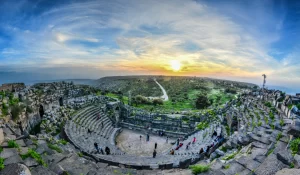
Umm Qais, located in the northern region of Jordan, is a hidden gem waiting to be explored by tourists seeking unique cultural and historical sites.
This ancient city, also known as Gadara, boasts a rich history dating back to the Hellenistic period and offers visitors a glimpse into the past through its well-preserved ruins and archaeological sites.
One of the main attractions in Umm Qais is the impressive Roman theater, which once hosted performances and gatherings in ancient times. Tourists can marvel at the grandeur of this structure and imagine the bustling cultural scene that once thrived within its walls.
In addition to the Roman theater, Umm Qais is home to a number of other fascinating ruins, including a Byzantine church, a mausoleum, and a colonnaded street.
Exploring these ancient remnants provides a fascinating insight into the city’s history and the diverse civilizations that once inhabited the area.
Beyond its historical significance, Umm Qais also offers stunning panoramic views of the surrounding landscape, including the Sea of Galilee and the Golan Heights.
Visitors can take in the breathtaking scenery while wandering through the ancient ruins, making for a truly unforgettable experience.
For tourists looking to immerse themselves in Jordan’s rich history and culture, Umm Qais is a must-visit destination that promises to captivate and inspire with its ancient wonders and scenic beauty.
6. Madaba Jordan:
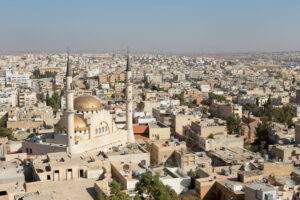
Madaba, a charming city located in Jordan, is a treasure trove of history, culture, and art that beckons tourists to explore its ancient wonders and historical sites.
Known as the “City of Mosaics,” Madaba is famous for its intricate mosaic artistry, with some of the finest examples dating back to the Byzantine era.
One of the must-visit attractions in Madaba is the St. George’s Greek Orthodox Church, home to the renowned Madaba Map, a stunning mosaic map of the Holy Land that dates back to the 6th century.
Tourists can marvel at the detailed craftsmanship of this ancient artwork and learn about its historical significance from knowledgeable guides.
In addition to its mosaic heritage, Madaba is also home to a number of other fascinating sites, including the Madaba Archaeological Park, which features ancient ruins and artifacts that offer a glimpse into the city’s past.
Visitors can explore the remains of Roman villas, Byzantine churches, and Umayyad structures, immersing themselves in the rich history of the region.
For those interested in experiencing modern Madaba, the city offers a vibrant marketplace where tourists can shop for traditional handicrafts, sample local cuisine, and interact with friendly locals.
With its blend of ancient history and contemporary culture, Madaba is a destination that promises to enchant and inspire visitors seeking a truly immersive travel experience in Jordan.
7. Kerak Castle Jordan:
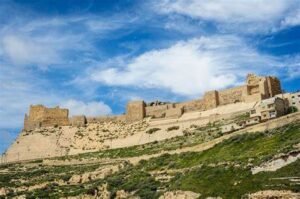
Kerak Castle, located in Jordan, is a must-visit destination for tourists seeking a glimpse into the rich history and stunning architecture of the region.
This ancient fortress, perched on a hilltop overlooking the town of Al-Karak, dates back to the 12th century and offers a fascinating insight into the Crusader period in the Middle East.
As you approach Kerak Castle, you will be struck by its imposing presence and well-preserved walls, which stand as a testament to the castle’s strategic importance in the past.
Once inside, visitors can explore the maze-like corridors, chambers, and courtyards that make up this sprawling complex.
Be sure to climb to the top of the castle for breathtaking views of the surrounding landscape, including the Dead Sea in the distance.
History buffs will appreciate the opportunity to learn about the castle’s storied past through informative displays and guided tours.
From its role in the Crusades to its later occupation by the Mamluks and Ottomans, Kerak Castle has witnessed centuries of conflict and cultural exchange.
For those seeking a more immersive experience, consider attending one of the castle’s special events or reenactments, which bring the history of Kerak Castle to life in a dynamic and engaging way.
After exploring the castle, take some time to wander through the charming town of Al-Karak, where you can sample local cuisine, shop for souvenirs, and interact with friendly locals.
Whether you’re a history enthusiast, architecture lover, or simply looking for a unique cultural experience, Kerak Castle is sure to leave a lasting impression on all who visit.
8. Mount Nebo Jordan:
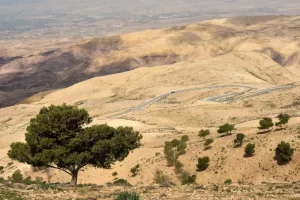
Mount Nebo, located in Jordan, is a must-visit destination for tourists seeking a blend of history, spirituality, and breathtaking views.
This ancient site holds significant religious importance as it is believed to be the place where Moses first saw the Promised Land before his passing.
Tourists can immerse themselves in the rich history of Mount Nebo by exploring the remains of a Byzantine church that once stood on the site.
The church’s intricate mosaics, depicting biblical scenes and symbols, offer a glimpse into the past and the religious significance of the area.
Aside from its historical significance, Mount Nebo also offers visitors stunning panoramic views of the Jordan Valley, the Dead Sea, and even Jerusalem on a clear day.
The sight of the sun setting over the vast landscape is truly a sight to behold and a perfect opportunity for capturing memorable photos.
For those seeking a spiritual experience, Mount Nebo provides a serene and contemplative atmosphere.
Visitors can take a moment to reflect and connect with their faith while surrounded by the peaceful surroundings of this sacred site.
To make the most of your visit to Mount Nebo, it is recommended to wear comfortable shoes for exploring the area and to bring plenty of water, especially during the hot summer months.
Additionally, hiring a local guide can enhance your experience by providing insights into the history and significance of the site.
Overall, a visit to Mount Nebo promises a unique blend of history, spirituality, and natural beauty, making it a must-see destination for tourists exploring Jordan.
9. Qasr Amra Jordan:
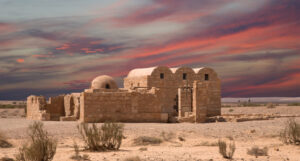
Qasr Amra, located in Jordan, is a fascinating historical site that offers tourists a glimpse into the rich cultural heritage of the region.
This UNESCO World Heritage Site is a desert castle dating back to the early 8th century and is renowned for its unique architecture and well-preserved frescoes.
As you approach Qasr Amra, you will be struck by its distinctive appearance, with its domed roof and fortified walls standing out against the desert landscape.
Once inside, visitors can explore the interior of the castle, which features a series of rooms adorned with intricate frescoes depicting scenes of hunting, bathing, and astrology.
These vibrant paintings provide valuable insights into the artistic and cultural practices of the Umayyad period in Jordan.
Tourists visiting Qasr Amra can also learn about the historical significance of the site through informative displays and guided tours.
The castle’s strategic location along ancient trade routes and its role as a leisure retreat for Umayyad rulers make it a fascinating destination for history enthusiasts.
Additionally, the tranquil surroundings of Qasr Amra offer visitors a peaceful and contemplative atmosphere, perfect for soaking in the beauty of the desert landscape and reflecting on the rich history of the region.
To make the most of your visit to Qasr Amra, be sure to wear comfortable shoes for exploring the castle grounds and bring plenty of water, especially during the hot summer months.
Hiring a local guide can also enhance your experience by providing valuable insights into the history and significance of this remarkable site. Overall, a visit to Qasr Amra promises a unique blend of history, art, and natural beauty, making it a must-see destination for tourists exploring Jordan.
10. Shobak Castle Jordan:
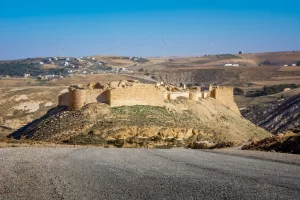
Shobak Castle, also known as Montreal, is a captivating historical site in Jordan that offers tourists a glimpse into the region’s medieval past.
12th-century Crusader castle on a hill showcases strategic importance during the Crusades, overlooking the landscape with historical significance.
As you approach Shobak Castle, you will be struck by its imposing stone walls and towers, which have stood the test of time and still exude a sense of strength and resilience.
Explore Shobak Castle’s chambers, halls, and passageways to learn about daily life and medieval military tactics used by its inhabitants.
The castle’s strategic location along ancient trade routes and its role in the defense of the region make it a fascinating destination for history buffs and architecture enthusiasts alike.
Tourists at Shobak Castle can enjoy panoramic views from the ramparts, providing a stunning backdrop for photos and nature appreciation.
The castle’s remote location adds to its allure, offering visitors a sense of stepping back in time and immersing themselves in the history of the region.
To make the most of your visit to Shobak Castle, be sure to wear comfortable shoes for exploring the castle grounds and bring plenty of water, especially during the hot summer months.
Hiring a local guide can enhance your experience by providing valuable insights into the history and significance of this remarkable site.
Visit Shobak Castle for history, architecture, and natural beauty, a must-see destination for tourists exploring Jordan.
Also known as Montreal, Shobak Castle is a Crusader fortress located in southern Jordan.
12th-century castle with defensive walls, towers, and underground chambers offers insight into the region’s medieval history.
Visitors can explore the castle’s ruins and enjoy panoramic views of the surrounding landscape from its strategic hilltop location.







